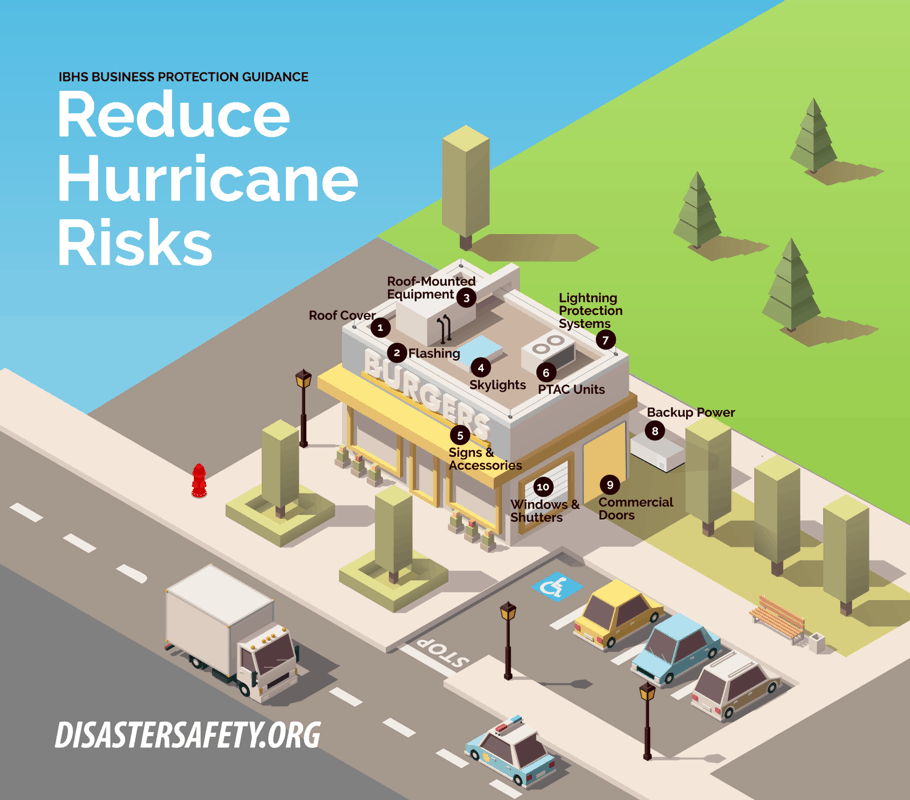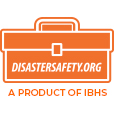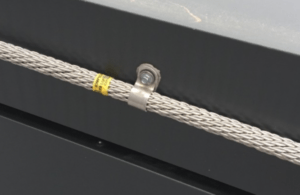Protecting your business from severe weather such as hurricanes not only requires resilient materials and building systems to withstand the elements—proper maintenance is also necessary to keep the building in good condition so that it performs as expected.
Address these 10 vulnerable areas of your commercial property to maintain their strength, durability, and functionality.
Note: All do-it-yourself maintenance guidance outlined in this article is to be completed under safe operating conditions. If fall protection is not available, it is best to hire a licensed contractor.

1
Ensure your roof is in good condition
The roof cover is one of the most vulnerable components of a building when exposed to the elements of a hurricane. Routine maintenance can prolong the life of your roof cover and can reduce roof damage during an event.
- Plan several inspections throughout the year to monitor the condition of your roof cover, particularly around season changes and after storms.
- Look for tears, bubbles, cracks, and ponding water.
- Remove excess debris and inspect for loose or missing materials regularly, and after any roof contractor does work on the roof.
Consider hiring a licensed roof contractor to conduct a scheduled preventative maintenance plan.
Learn more about how to inspect and maintain your roof.
2
Perimeter Flashing
Roof flashing refers to the strips of metal or other material installed around the roof edge where the roof cover meets the wall. When the flashing is compromised, it leaves important building systems including the roof cover vulnerable to the elements (such as wind-driven rain) which can cause significant damage.
- Check for loose or ill-fitted perimeter flashing, which greatly increases the potential for roof cover failures.
- Hire a contractor to repair loose or damaged flashing per the manufacturer instructions/ guidance.
3
Roof-Mounted Equipment
During a high-wind event, unsecured equipment is subject to sliding, lifting, and overturning. This can cause significant damage to a roof cover and water intrusion.
- Securely attach equipment to a curb that is at¬tached to the roofing structure. Inspect equipment for any loose or missing connections.
- Inspect for loose flashing around roof-mounted equipment, curbs, and roof hatches, which could lead to potential failures of the unit’s structure and water intrusion.
- Clear all debris around and under roof-mounted equipment. Debris can cause water to pond, which could cause costly damage to the roof and interior.
- Ensure service panels have all fasteners in place, so panels do not become dislodged.
4
Skylights
When damaged or not properly attached, skylights can cause a breech in the building envelope, leading to significant interior damage.
- Regularly inspect skylights for cracks and leaks; also inspect securements to the curb and address any rotting.
- Hire a contractor to repair or replace damaged skylights.
5
Signs and Accessories
Outdoor signs and accessories (such as inventory) can become windborne debris if not adequately secured or stored.
- Throughout the year and after storms, inspect outdoor signs to ensure connections function properly, have no missing bolts or screws, and are free from rust.
- Before a storm, verify that sign connections are adequate or remove the sign and properly store.
- Store outdoor inventory in a safe location protected from high winds.
6
Packaged Terminal Air Conditioners (PTAC)
For some commercial properties such as hotels, the use of PTAC units is very common. Before a storm, check these units to make sure they are properly installed and will be able to resist wind-driven rain. Costly damage can be caused by the leakage of these units.
- Ensure all PTAC units are tilted towards the outside of the building. IBHS research found that internally tilted PTAC units can cause interior water damage from wind-driven rain. Hire a contractor to fix the unit.
- Inspect the weather stripping between the PTAC unit and sleeve to ensure it has been installed correctly and consistently—otherwise, this can increase the risk of water entry.
- Examine caulking around PTAC units to determine if any damage or improper caulking has occurred.
7
Lightning Protection Systems
Lightning protection systems can serve as defense against dangerous lightning strikes to your building. However, if they are not properly attached, they are no longer capable of providing the intended protection; this also can cause damage to other structures or roof components during a hurricane. Proper maintenance of these systems can help prevent tears or other significant damage to your roof cover.
- During routine inspections, check the lightning protection system by gently pulling on the securements and conductor poles. If they are loose or disconnected, hire a licensed contractor.
- If replacement or a new cable connector is required, install a closed loop connector rather than a conventional 3-prong connector. If the metal conductor cable becomes loose from its securement, it can be dragged or slammed against the roof membrane.
→Learn more from the Lightning Protection Institute (LPI) at lightning.org.
8
Backup Power
An onsite generator is a critical defense against electrical interruption and business downtime. A generator is an independent source of electricity that powers important electrical utilities when the normal power supply is not active.
- Business and building owners should always operate and maintain generators in accordance with manufacturer recommendations, including periodic testing and refreshing of fuel (for portable generators).
- Store portable generators in a dry location when they are not in use.
- Only operate portable generators outside in a well-ventilated area. Operation in a garage or similar setting, which might seem ventilated, is strongly discouraged and is one of the leading causes of carbon monoxide poisoning.
9
Commercial Doors
Commercial doors are common on commercial properties and play an imperative role in productivity. When damaged by wind or debris, these doors can lead to costly roof and interior damage.
- Inspect the brackets that connect the door frame to the structure. Ensure they are tightly secured, not missing any bolts or nuts, and are not broken.
- Examine all the elements of the panels for dents, damage, warping and/or rusting. If significant, hire a contractor to fix or replace the commercial door.
- Consider contacting a commercial door contractor to determine if your doors are properly wind rated. Retrofit improvements can be cost-effective.
10
Windows and Shutters
Keeping wind and water out of your business is key to survival during a hurricane. All windows and glass in doors should be properly protected with impact-rated glass or a shutter system. Proper maintenance ensures the strength and easy deployment of these protection systems well before landfall of a storm.
- When conducting regular inspections, check impact-rated windows for any damage or ill-fitted gaskets. This could lead to water infiltration and other costly damages. Hire a contractor to fix damaged gaskets.
- Inspect the connections of permanent shutters. Ensure all fasteners are properly embedded into the structure and that shutters are tightly attached.
- Regularly test that all shutters operate properly. This will ensure the shutters will deploy prior to a landfall.
- Store and maintain all temporary shutters, such as plywood, flat and in a dry location.









5 Comments